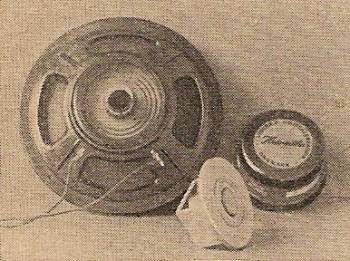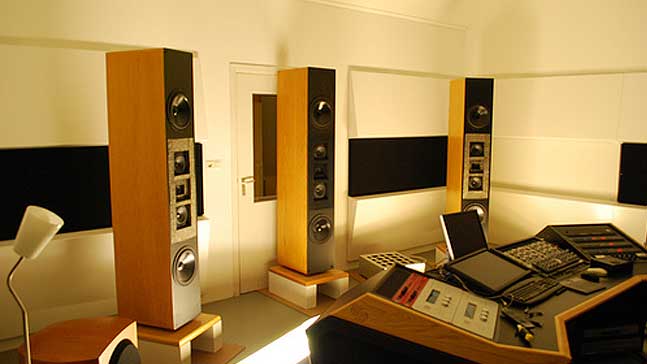

|
The Rise and Evolution of Accurate Reference Monitors
The Danish Connection
by Dan Richards

Living in Copenhagen, Denmark and working in recording studios for most of the 90s, I was familiar with the background of many Danish companies within the audio industry. In researching Danish loudspeaker history, my years of learning to speak the language payed off, as I was able to access some of the information written in Danish. Skål!
In this ongoing series on the rise of accurate monitors, this article will, perhaps, read more like a bullet-pointed reference. The timespan is nearly a century and highlights the development of transducers by Danish companies. Denmark has been called "the birthplace of the loudspeaker." And while there certainly have been discoveries and advancements from around the globe, no single geographical area and culture has contributed more to the advancement of the modern loudspeaker than the land from whence the Vikings came.
The history of companies such as Peerless, Vifa, Scan-Speak, Dynaudio, and SEAS are often interwoven throughout the years, and have shared many common founders, personnel, research, technologies, developments, and owners. SEAS is technically a Norwegian company, but had strong ties with Denmark, and one of its founders was a Dane.

Peerless was founded in 1926 in Denmark by Einar Skjold Petersen and his cousin, T.M. Larsen.
Vifa was founded in 1933 in Denmark by N.C. Madsen. Madsen often visited his two brothers who worked at Bang & Olufsen, and all three brothers conducted experiments to develop loudspeakers for B&O;, which until that point has been supplied by a company in Frankfurt, Germany.
In 1956 the Scandinavian Electro Acoustic Systems, or SEAS, was formed in Norway.
In 1961. Jan Wessel and C.C. Nørgaard; Madsen, two owners of SEAS bought Videbaek Højttalerfabrik; (speaker factory) (Known today as Vifa)
Scan-Speak was founded in 1970 by Ejvind Skaaning, who later went on to found Dynaudio in 1977. Skanning operates today with his son Per at Audio Technology by Skanning.

The very first moving-coil (dynamic) loudspeaker was invented by Dane, Peter L Jensen, who founded Jensen Loudspeakers, which, among other accomplishments, supplied Fender, Ampeg, and Gibson with speakers for their amplifiers. Fender still uses Jensen speakers in their Twin Reverb amp.
Per Vilhelm Brüel founded Brüel & Kjær, the sound and vibration measurement equipment company. Danish Pro Audio, (DPA) was founded by two B&K; employees in 1992. B&K; measurement microphones and audio analysers have played an important role, and are still widely used for testing by the transducer companies mentioned herein. Brüel was close friends with physicist Niels Bohr.
The first 1" dome tweeter, the SEAS H086, was designed by Bjørn; Børja;.

Did you know that pastries around the world called "Danishes" were actually developed in Vienna, Austria? The pastries in Denmark and Northern Europe are called "wienerbrød;" (Vienna bread).
In 1974, Ejvind Skaaning entered a joint-venture with partners Gerhard Richter and Meir Mordechai to form the RMS. RMS stood for Richter, Mordechai, and Skanning.
Mordechai, an Israeli, bought Skaaning's and Richter's shares after two years in business, and formed Morel. Skaaning returned to Denmark and remained partners with Richter, and took the same design approach they had used with the RMS product line and launched Dynaudio in 1977.
In 1983, former Scan-Speak employee, head of product design, development, production, and technical manager, Oskar Wrønding;, founds Hiquphon.
Videbæk Hørjttalerfabrik; (speaker factory) bought Scan-Speak in 1989, but continued development and sales of Vifa and Scan-Speak as separate brands. Vifa was known as "good" and cost-effective, and Scan-Speak was the advanced and "refined" brand. In 2000 Peerless was purchased by Videbæk Hørjttalerfabirk;, and branded under the new name DST, Danish Sound Technology. The brands Peerless, Vifa, and Scan-Speak all being produced under the same ownership.
In 2000 Vifa and Peerless merged into Danish Sound Technology (DST) with manufacturing moved to PanYu, China under Tymphany.
In 2005 Tymphany and Danish Sound Technology (DST) announce a merger.
In April of 2009, Scan-Speak announced, Scan-Speak back in Danish hands. An important feature of the brand is that individual products are based on Danish product development, know-how and technology. The fact that the company is Danish-owned and that all production is done by hand adds significant value which is very difficult to measure in monetary terms.
SEAS, was acquired by a Singapore/Canadian company named Sonavox Group. They also moved the manufacturing to China.
In April 2014 Scan-Speak announces its acquisition by Eastern Asia Technology (HK) Limited. Interestingly enough, EASTECG had purchased Tymphany in 2008, but had to sell the company to raise capital to build flat screen TV panels.
John Dunlavy commenting on his use of drivers in his loudspeaker designs:
DALJHD quotes:
"Once again, when choosing drivers for use in DAL loudspeakers, I never look at price or appearance. This is because appearance and price do not correlate with performance.Indeed, almost all of the expensive, high-tech looking drivers with hi-tech cones, etc., exhibit performance (especially impulse, step, ampl/freq., etc., ) that does not approach what we achieve with Vifa or Scan Speak drivers and a good (but complex) compensated, first-order crossover. (Yes, 'compensated' because even the best drivers do not yield an amplitude vs freq. response better than about plus/minus 5 dB.) Likewise, what are often referred to as "paper cones" are not paper but a complex, proprietary blend of 'pulp, binders, carbon fibers, etc.'."
John Dunlavy is quoted in this archived forum post as stating:
"The 'high-tech' looking drivers don't approach what can be achieved with Vifa or Scan-Speak drivers and a good first-order crossover."

Dunlavy Audio Lab SCIV'sThe rest of the post continues:
"And, considering the vague definition of 'accuracy' being used by many of today's magazine writers, etc., is it any wonder that most audiophiles are confused? Indeed, it seems that "accuracy" is being treated as if was merely a matter of 'taste, personal opinion, etc.'. But is there not a 'real' accuracy that can be 'measured' and confirmed by 'real-time comparisons with live music and voices'?Does not true objective accuracy of reproduction depend upon how accurately the original complex musical waveforms are reproduced by the entire audio system - including the loudspeakers? If we ask that high quality amps, DVD players, etc. be able to accurately reproduce squarewaves, impulses and other complex waveforms (like a lot of musical waveforms), why not require the same from loudspeakers? I believe the answer is an obvious 'yes', for loudspeakers, being one component of a "series system" should exhibit the same levels of accuracy we demand from all other components of our system.
Just because most loudspeakers cannot reproduce squarewaves, impulses, etc. with even a cursory level of accuracy, is no reason not to ask more designers to improve their 'act'."
The references included are by no means exhaustive. But rather a jumping off point and some road signs to use for gleaning the Danish connection of transducer development, and the inclusion of their OEM products by the finest loudspeaker manufacturers in the world—whether they openly admit it or not.
Vi sez.
For further reading, Claus Futtrup has written History Book of the Danish Loudspeaker Industry.
There's a beautiful, free PDF copy available online of the new book, Danish Loudspeakers: 100 Years
Copyright. All rights reserved 2002 - 2022 Pro Studio Review